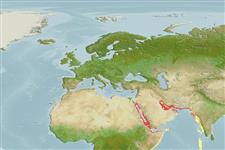Common names from other countries
>
Gobiiformes (Gobies) >
Gobiidae (Gobies) > Gobiinae
Etymology: Gobiodon: Latin, gobius = gudgeon + Greek, odous = teeth (Ref. 45335); bilineatus: Named for its two distinct, bright blue lines through the eye, the remaining distinct colour pattern that remains in the largest adults when alive; from Latin words 'bi' for two and 'linea' for line..
Environment: milieu / climate zone / depth range / distribution range
Sinh thái học
Biển Cùng sống ở rạn san hô. Tropical
Indo-West Pacific: most probalby within the whole area; collected from the Gulf of Aqaba, Red Sea.
Bộ gần gũi / Khối lượng (Trọng lượng) / Age
Maturity: Lm ? range ? - ? cm
Max length : 3.6 cm SL con đực/không giới tính; (Ref. 94082)
Short description
Khóa để định loại | Hình thái học | Sinh trắc học
Các tia vây lưng cứng (tổng cộng) : 6; Các vây lưng mềm (tổng cộng) : 10 - 11; Tia cứng vây hậu môn: 1; Tia mềm vây hậu môn: 8; Động vật có xương sống: 26. This species is distinguished by the following characters: D VI+I,10-11; A I,8-9 (usually 9); head and body naked; body slightly compressed and relatively elongate (body depth at pelvic-fin origin 36-40% SL), dorso-ventrally symmetrical; distance between D1 insertion and dorsal insertion of pectoral-fin 53-71% of head length; rounded head with upper lip curved; small mouth, upper jaw extending to anterior margin of the eye; groove between isthmus and interopercle absent; caudal peduncle deep (minimal depth 16.3-17.9% SL); caudal fin relatively short (21.7-23.2% SL). Colour of juveniles and subadults light greenish or reddish with 5 vertical blue lines on head while adults are usually uniformly orange-red or dark red, sometimes with remnants of lines on the head but always with 2 distinct bluish lines through the eyes, sometimes extending ventrally to suborbital area; dorsal and anal fin usually with a narrow light bluish band along bases, fading with growth (Ref. 94082).
Facultative air-breathing in the genus (Ref. 126274); Usually occupies the reef slope and fore reef areas and often in large colonies of Acropora samoensis but also present in Acropora secale and A. gemmifera in northern Red Sea (Ref. 94082).
Life cycle and mating behavior
Maturities | Sự tái sinh sản | Spawnings | Egg(s) | Fecundities | Ấu trùng
Herler, J., S.V. Bogorodsky and T. Suzuki, 2013. Four new species of coral gobies (Teleostei: Gobiidae: Gobiodon), with comments on their relationships within the genus. Zootaxa 3709(4):301-329. (Ref. 94082)
IUCN Red List Status (Ref. 130435)
CITES (Ref. 128078)
Not Evaluated
Threat to humans
Harmless
Human uses
Các công cụ
Special reports
Download XML
Các nguồn internet
Estimates based on models
Preferred temperature (Ref.
115969): 24.8 - 29.3, mean 28 (based on 172 cells).
Phylogenetic diversity index (Ref.
82804): PD
50 = 0.5000 [Uniqueness, from 0.5 = low to 2.0 = high].
Bayesian length-weight: a=0.01995 (0.00906 - 0.04395), b=3.01 (2.83 - 3.19), in cm Total Length, based on all LWR estimates for this body shape (Ref.
93245).
Mức dinh dưỡng (Ref.
69278): 3.3 ±0.4 se; based on size and trophs of closest relatives
Thích nghi nhanh (Ref.
120179): Chiêù cao, thời gian nhân đôi của chủng quần tối thiểu là dưới 15 tháng (Preliminary K or Fecundity.).
Fishing Vulnerability (Ref.
59153): Low vulnerability (10 of 100).
